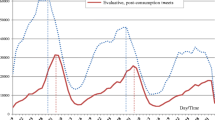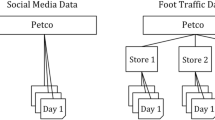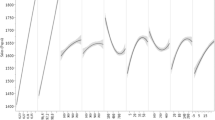Abstract
Firms are increasingly focusing on understanding and managing their social media strategies in order to create discussions and optimize the spread of news in their communities. Most prior studies on information dissemination have mainly focused on the roles of influentials but ignored the essential for noninfluentials. To fill this gap, this paper takes a holistic view of the information dissemination process and investigates how the participation of both influentials and noninfluentials plays a role in affecting the volume and sentiment of microblogs, which are precursors to raise awareness and attraction for brands. To test our hypotheses, we build a novel econometric model and apply it to a dataset collected from the popular microblogging site Twitter. We have the following main results: (1) back-and-forth-type discussions and retweets are effective in generating awareness and positive attractiveness; (2) influentials or mavens (who have many followers but seldom follow others) help generate initial sparks toward microblogging, but during the cascading periods, the noninfluentials play an important role in driving the conversations; and (3) new users who gradually join the discussions also help increase awareness, although they may not generate a positive sentiment. Our results provide important implications for mediating consumer interactions and firms’ marketing strategies.


Similar content being viewed by others
Notes
In his book, Gladwell describes three kinds of people: connectors, mavens, and salesmen. To apply his idea in the microblogging context, we use the word “negotiators” instead of “salesmen” to explicitly emphasize the discussions and persuasions going on when people post microblogs. This is in line with what Gladwell says on page 80: “What happens when two people talk? That is really the basic question here, because that’s the basic context in which all persuasion takes place. We know that people talk back and forth.”.
Due to the quota limit imposed by the Twitter Search API, we refrain from collecting the news articles mentioned in all microblogs returned in the query results. If more computing resources were available (e.g., more computers with unique IP addresses), one can expand the sample size by including news articles appearing in all microblogs in the query results.
For example, according to a recent campaign, a firm was promoting the success of the results of a Twitter campaign: The campaign reached 3,628,525 users on Twitter with a 1.24% average click-through rate and generated an 8.0c effective cost per click. Increasing the impact of such campaigns, lowering the cost, and increasing the awareness are possible using our model.
References
Amemiya T (1985) Advanced econometrics. Harvard University Press, Boston
Anderson EW, Salisbury LC (2003) The formation of market-level expectations and its covariates. J Consum Res 30(1):115–124
Aral S, Muchnik L, Sundarajan A (2009) Distinguishing influence-based contagion from homophily-driven diffusion in dynamic networks. PNAS 106(51):21544–21549
Aral S, Walker D (2012) Creating social contagion through viral product design: a randomized trial of peer influence in networks. Manage Sci 57(9):1623–1639
Aral, S. (2013a) What would ashton do—and does it matter? Harvard Bus Rev 91(5):25–27
Aral S (2013b) To go from big data to big insight, start with a visual. https://hbr.org/2013/08/visualizing-how-online-word-of.html
Asur S, Huberman AB, Gabor S, Wang C (2011) Trends in social media: persistence and decay. Fifth international AAAI conference on weblogs and social media
Bernoff J, Li C (2008) Harnessing the power of the oh-so-social web. Sloan Manag Rev 49(3):36–42
Biyalogorsky E, Gerstner E, Libai B (2001) Customer referral management: optimal reward programs. Mark Sci 20(1):82–95
Bohlmann JD, Calantone RJ, Zhao M (2010) The effects of market network heterogeneity on innovation diffusion: an agent-based modelling approach. J Prod Innov Manage 27:741–760
Bounie D, Bourreau M, Gensollen M, Waelbroeck P (2008) Do online customer reviews matter? Evidence from the video game industry. Working paper ESS-08-02, Department of Economics and Social Sciences, Telecom ParisTech
Bowman D, Narayandas D (2001) Managing customer-initiated contacts with manufacturers: the impact on share of category requirements and word-of-mouth behavior. J Mark Res 38(3):281–297
Brooks RC (1957) “Word-of-mouth” advertising in selling new products. J Mark 22(2):154–161
Burnkrant RE, Cousineau A (1975) Informational and normative social influence in buyer behavior. J Consum Res 2:206–215
Buttle FA (1998) Word of mouth: understanding and managing referral marketing. J Strateg Mark 6(3):241–254
Centola D (2010) The spread of behavior in online social network experiment. Science 329:1194
Cha M, Haddadi H, Benevenuto F, Gummadi KP (2010) Measuring user influence in twitter: the million follower fallacy. Proceedings of the fourth international AAAI conference on weblogs and social media
Chen Y, Xie J (2008) Online consumer review: word-of-mouth as a new element of marketing communication mix. Manage Sci 54(3):477–491
Cheng J, Sun A, Hu D, Zeng D (2011) An information diffusion based recommendation framework for micro-blogging. J Assoc Inf Syst 12(7):463–486
Childers TL (1986) Assessment of the psychometric properties of an opinion leadership scale. J Mark Res 23(2):184–188
Coleman JS, Katz E, Menzel H, Columbia University Bureau of Applied Social Research (1966) Medical innovation: a diffusion study. Bobbs-Merrill Company, New York
Dellarocas C, Awad NF, Zhang X (2004) Exploring the value of online reviews to organizations: implications for revenue forecasting and planning (ICIS–25)
Deutsch M, Gerard HB (1955) A study of normative and informational social influences upon individual judgment. J Abnorm Soc Psychol 51(3):629–636
Dholakia UM, Bagozzi RP, Pearo LK (2004) A social influence model of consumer participation in network- and small-group-based virtual communities. Int J Res Mark 21(3):241–263
Fang X, Hu PJH, Li Z, Tsai W (2013) Predicting adoption probabilities in social networks. Inf Syst Res 24(1):128–145
Feick LF, Price LL (1987) The market maven: a diffuser of marketplace information. J Mark 51(1):83–97
Fisher D, Smith M, Welser HT (2006) You are who you talk to: detecting roles in usenet newsgroups. Hawaii Int Conf Syst Sci (HICSS) 3:59b
Flynn LR, Goldsmith RE, Eastman JK (1996) Opinion leaders and opinion seekers: two new measurement scales. J Acad Mark Sci 24(2):137–147
Galeotti A, Goyal S (2010) The law of the few. Am Econ Rev 100(4):1468–1492
Geissler GL, Edison SW (2005) Market mavens’ attitudes towards general technology: implications for marketing communications. J Mark Commun 11(2):73–94
Gladwell M (2000) The tipping point. Little Brown
Glock CY, Nicosia FM (1964) Uses of sociology in studying consumption behavior. J Mark 28(3):51–54
Goldenberg J, Han S, Lehmann DR, Hong JW (2009) The role of hubs in the adoption process. J Mark 73:1–13
Gomez-Rodriguez M, Leskovec J, Schölkopf B (2013) Structure and dynamics of information pathways in online media. In: Proceedings of the sixth ACM international conference on Web search and data mining (WSDM’13). ACM, New York, NY, USA, pp 23–32
Granovetter MS (1973) The strength of weak ties. Am J Sociol 78(6):1360–1380
Green J, Hand JRM, Penn MW Jr (2012) The bad news dissemination bias in the business press. Available at http://leeds-faculty.colorado.edu/zeyun/workshop12-13_files/ghp%2020120816.pdf
Gunnec D, Raghavan S (2012) Integrating social network effects in product design. Working paper, University of Maryland
Guo L, Tan E, Chen S, Zhang X, Zhao Y (2009) Analyzing patterns of user content generation in online social networks KDD’09 Paris France, 369–377
Guo X, Vogel D, Zhou Z, Zhang X, Chen H (2009) Chaos theory as a lens for interpreting blogging. J Manag Inf Syst 26(1):101–127
Hennig-Thurau T, Walsh G (2003) Electronic word of mouth: motives for and consequences of reading customer articulations on the internet. Int J Electron Commer 8(2):51–74
Iyengar R, Van den Bulte C, Valente TW (2011) Opinion leadership and social contagion in new product diffusion. Mark Sci 30(2):195–212
Keller EB, Berry JL (2003) The influentials: one american in ten tells the other nine how to vote, where to eat, and what to buy. The Free Press, New York
Kleinberg J (2007) Cascading behavior in networks: algorithmic and economic issues. In: Nisan N, Roughgarden T, Tardos E, Vazirani V (eds) Algorithmic game theory. Cambridge University Press, Cambridge, MA
Kwak HK, Lee C, Park H, Moon S (2010) What is twitter, a social network or a news media? World Wide Web Conference Committee (IW3C2)
Kwon J, Han I (2013) Information diffusion with content crossover in online social media: an empirical analysis of the social transmission process in Twitter (HICSS-46). 3292–3301
Li Q, Wang J, Chen YP, Lin Z (2010) User comments for news recommendation in forum-based social media. Inf Sci 180(24):4929–4939
Lin TF, Schmidt P (1984) A test of the tobit specification against an alternative suggested by Cragg. Rev Econ Statistics 66(1):174–177
Liu Y (2006) Word of mouth for movies: its dynamics and impact on box office revenue. J Mark 70(3):74–89
Lu Y, Jerath K, Vir Singh P (2013) The emergence of opinion leaders in a networked online community: a dyadic model with time dynamics and a heuristic for fast estimation. Manage Sci 59(8):1783–1799
Maddala GS (1983) Limited-dependent and qualitative variables in econometrics. Cambridge University Press, Cambridge
McGuire WJ (1978) An information-processing model of advertising effectiveness. In: Davis Harry L, Silk Alvin H (eds) Behavioral and management science in marketing. Ronald Press, New York, pp 156–180
Meyer MH, Lehnerd A (1997) The power of product platforms: building value and cost leadership. The Free Press, New York
Mishne G, Glance N (2006) Predicting movie sales from blogger sentiment. AAAI 2006 spring symposium on computational approaches to analyzing weblogs
Muffato M, Roveda M (2002) Product architecture and platforms: a conceptual framework. Int J Technol Manage 24(1):1–16
Muniz A, O’Guinn T (2001) Brand community. J Consum Res 27(4):412–432
Ovide S (2012) Twitter’s mobile ads begin to click. WSJ online June 28, 2012. Retrieved from http://online.wsj.com/article/SB10001424052702304458604577491170573156612.html
Pal A, Counts S (2011) Identifying topical authorities in microblogs. In: Proceedings of the fourth ACM international conference on Web search and data mining, pp 45–54
Pintado DL (2004) Diffusion in complex social networks university of alicante, Working paper
Pralahad CK, Ramaswamy V (2004) The future of competition: co-creating unique value with customers. Harvard Business Review Press, Boston
Robinson PM, Bera AK, Jarque CM (1985) Tests for serial dependence in limited dependent variable models. Int Econ Rev 26(3):629–638
Rogers EM (1995) Diffusion of innovations. The Free Press, New York
Schau HJ, Muñiz AM, Arnould EJ (2009) How brand community practices create value. J Mark 73(5):30–51
Shell A (2011) Wall street traders mine tweets to gain a trading edge. USA Today May 4. http://www.usatoday.com/money/perfi/stocks/2011-05-03-wall-street-traders-mine-tweets_n.htm
Shi M (2003) Social network-based discriminatory pricing strategy. Mark Lett 14(4):239–256
Shi Z, Rui H, Whinston A (2014) Content sharing in a social broadcasting environment: evidence from Twitter. MIS Q 38(1):123–142
Soroka SN (2006) Good news and bad news: asymmetric responses to economic information. J Politics 68(2):372–385
Stieglitz S, Dang-Xuan L (2013) Emotions and information diffusion in social media—sentiment of microblogs and sharing behavior. J Manag Inf Syst 29(4):217–248
Susarla A, Oh J, Tan Y (2012) Social networks and the diffusion of user-generated content: evidence from youtube. Inf Syst Res 23(1):23–41
Van den Bulte C, Lilien GL (2001) Medical innovation revisited: social contagion versus marketing effort. Am J Sociol 106(5):1409–1435
Van Eck PS, Jager W, Leeflang PSH (2011) Opinion leaders’ role in innovation diffusion: a simulation study. J Prod Innov Manage 28:187–203
Vascellaro JE (2009) Firms seek profit in twitter’s chatter. WSJ online March 25, 2009
Vascellaro JE, Steel E (2010) Twitter rolls out ads. WSJ online April 14
Wasserman S, Faust K (1994) Social network analysis: methods and applications. Cambridge University Press, Cambridge
Wattal S, Racherla P, Mandviwalla M (2010) Network externalities and technology use: a quantitative analysis of intraorganizational blogs. J Manag Inf Syst 27(1):145–173
Watts DJ, Dodds PS (2007) Influentials, networks, and public opinion formation. J Consum Res 34(4):441–458
Waugh R (2012) The tweets are paved with gold: Twitter “predicts” stock prices more accurately than any investment tactic, say scientists. http://www.dailymail.co.uk/sciencetech/article-2120416/Twitter-predicts-stock-prices-accurately-investment-tactic-say-scientists.html
Yang J, Leskovec J (2010) Modeling information diffusion in implicit networks. In: Proceedings of the 2010 ieee international conference on data mining, 599–608
Zeger SL, Brookmeyer R (1986) Regression analysis with censored autocorrelated data. J Am Stat Assoc 81(395):722–729
Zhao D, Rosson MB (2009) How and why people twitter: the role that micro-blogging plays in informal communication at work. In: Proceedings of the ACM 2009 international conference on supporting group work. ACM: 243–252
Zhou Y, Guan X, Zheng Q, Sun Q, Zhao J (2010) Group dynamics in discussing incidental topics over online social networks. IEEE Network Nov/Dec:42–47
Author information
Authors and Affiliations
Corresponding author
Additional information
The author thanks Tubitak (#111K476) for sponsorship of this research
Rights and permissions
About this article
Cite this article
Akcura, T., Altinkemer, K. & Chen, H. Noninfluentials and information dissemination in the microblogging community. Inf Technol Manag 19, 89–106 (2018). https://doi.org/10.1007/s10799-017-0274-z
Published:
Issue Date:
DOI: https://doi.org/10.1007/s10799-017-0274-z




